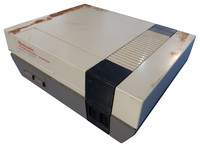Nintendo Entertainment System (Mattel Version)
| Home > Browse Our Collection > Games Consoles > Nintendo > Nintendo Entertainmen ... stem (Mattel Version) |
|
This is an early NES console distributed by the toy company Mattel. Due to Nintendo's initial indifference to the European market it was not a great success, the Home Micros dominated the market at the time, where games were considerably cheaper than the cartridges Nintendo used, and there was also a steady stream of pirated software going round too. In 1988, Nintendo themselves took over distribution, and relabelled them NES Version, rather than Mattel version. After the enormous success of the Famicom in Japan, launched in 1983, Nintendo, a company formed nearly 100 years before, manufacturing game cards, began looking for overseas expansion. After performing test markets in New York, with varying success, the machine was eventually launched nationwide in the US in September 1986. Nintendo had learned much from the videogame crash the US suffered in 1983, resulting from confusion between the different brands, near identical games appearing on the same machines, with a huge contrast in quality in both graphics and sound, resulting in a the general lack of faith from retailers and consumers. They aimed to tighten control on what companies could produce for the machine, putting forward a single platform with technology that was a step up from what had gone before, and with boxes that contained the exact graphics of the game, with no exaggeration, this gained the company a ‘what you see is what you get’ reputation, restoring confidence in a broken market. Nintendo issued licenses to games companies, which were not easy to come by, especially western companies, limiting them to only ten titles a year, each game had to be approved, all cartridges had to be manufactured by Nintendo, with a seal of quality printed on the box, further boosting the confidence in the brand. Some companies would set up subsidiaries, Konami created Palcom for instance, so they would not be restricted to just ten games. The NES in America was a massive success, selling well over 30 million machines, it is estimated there was a NES in one in three households, bolsted by some superb software such as the Super Mario series, as well as a steady stream of quality titles from third party publishers, who if they entered a licensing agreement with Nintendo were not allowed to publish games for a rival machine. Eventually losing some high profile cases in the US courts over unauthorised games being produced for the machine, and being manufactured outside of Nintendo’s licensing framework. Fearing the loss of the US market they looked elsewhere to Europe and beyond to sell the machine, with less strict rules, markets to which they had been indifferent to until then, with only a limited launch with Mattel doing the distribution. After being effectively locked out of the Japanese and US markets by Nintendo’s practices, especially where third parties were concerned, Sega had long seen Europe as a lucrative market, and had firmly established the Master System as the leading console in that territory, so Nintendo found it very hard to get a firm sales foothold in that region, a pack in game from Palcom cashed in on the craze for Teenage Mutant Hero turtles just in time for the Christmas market in 1990, finally allowing Nintendo a decent market share. The machine’s popularity meant it stayed in production until 1995, Nintendo would still service the machine for a full decade after that. Manufacturer: Nintendo This exhibit has a reference ID of CH64700. Please quote this reference ID in any communication with the Centre for Computing History. |
Click on the Image(s) For Detail
|











